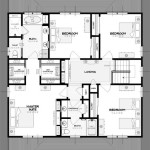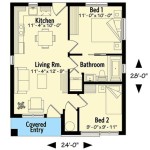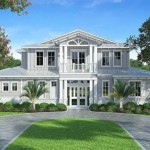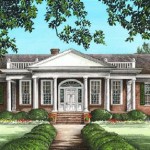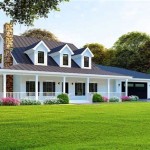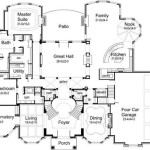House Plans For Narrow Lots With Rear Garage
Building a home on a narrow lot presents unique design challenges. The limited width necessitates creative solutions to maximize living space, maintain functionality, and adhere to local zoning regulations. One increasingly popular approach is incorporating a rear garage. This design strategy moves the garage to the back of the property, freeing up the front of the house for a more aesthetically pleasing facade and potentially increasing the usable square footage for living areas. This article explores the key considerations, benefits, and examples of house plans for narrow lots with a rear garage.
Optimizing Space and Layout in Narrow Lot House Plans
The primary challenge when designing for narrow lots is efficient space utilization. Every square foot counts, and the floor plan must be meticulously planned to avoid feeling cramped or cluttered. Vertical expansion is often a crucial element. Two or three-story designs are common, allowing for more living space without increasing the building's footprint. Thoughtful interior design also plays a vital role; open-concept layouts can make a narrow home feel more spacious by eliminating dividing walls between living, dining, and kitchen areas.
Strategic placement of windows is another essential consideration. Large windows, particularly those facing the front and rear of the house, can bring in natural light and create a sense of openness. Skylights can also be used to illuminate interior spaces that may not have direct access to windows. The orientation of the house should be carefully considered to maximize sunlight exposure throughout the day.
The design of the rear garage itself needs to be carefully integrated into the overall plan. Detached garages offer more flexibility in terms of placement and design, but attached garages can be more convenient and cost-effective. If an attached garage is chosen, the connection to the main house should be seamless and functional. A mudroom or entry area connecting the garage to the kitchen or living area can provide a convenient space for storage and organization.
Particular attention should be given to circulation patterns within the house. Hallways should be minimized, and rooms should flow seamlessly into one another. The placement of stairs is also crucial; a centrally located staircase can divide the house effectively, while a staircase tucked away in a corner can save space and improve flow.
Outdoor living spaces can also enhance the appeal of a narrow-lot home. A small backyard or patio can provide a valuable extension of the living area, especially when coupled with a rear garage design. Decks or balconies on upper floors can also offer outdoor space and scenic views. The design of these outdoor spaces should complement the overall aesthetic of the house and provide privacy from neighboring properties.
Advantages of a Rear Garage on a Narrow Lot
The decision to incorporate a rear garage into a narrow lot house plan offers several advantages that can significantly enhance the property's functionality and value. These advantages revolve around maximizing usable space, improving curb appeal, and optimizing traffic flow.
Enhanced Curb Appeal: Placing the garage at the rear of the property allows for a more attractive and welcoming front facade. Instead of a large garage door dominating the view, the front of the house can be designed with architectural details, landscaping, and a welcoming entryway. This can significantly increase the property's curb appeal and make it more attractive to potential buyers.
The design flexibility afforded by a rear garage allows for more creativity in the front elevation. Porches, bay windows, and other architectural features can be incorporated without being overshadowed by the garage. The front yard can be landscaped to create a more inviting and aesthetically pleasing environment.
Increased Living Space: By moving the garage to the back, the front of the house can be used for additional living space. This can be particularly beneficial in narrow lots where every square foot is valuable. The space that would have been occupied by the garage can be used for a larger living room, a home office, or an additional bedroom.
This design strategy can also improve the flow of the house. The front of the house can be designed as a dedicated living area, separate from the garage entrance, creating a more peaceful and comfortable environment. The rear garage entrance can be designed as a more functional space, such as a mudroom or laundry area, providing a convenient transition from the garage to the main living areas.
Improved Privacy: A rear garage can provide increased privacy for both the house and the backyard. By detaching the garage from the main house, a buffer zone is created between the street and the living areas. This can reduce noise and visual intrusion from passing traffic, creating a more peaceful and private environment.
The location of the garage can also enhance the privacy of the backyard. It can act as a screen between the house and neighboring properties, creating a more secluded outdoor space. This can be particularly beneficial in densely populated areas where privacy is highly valued.
Potential for Accessory Dwelling Unit (ADU): Depending on local zoning regulations, a rear garage can also provide the potential for an accessory dwelling unit (ADU). An ADU is a self-contained living unit that is located on the same property as the main house. This can be a separate apartment above the garage, or a small cottage in the backyard. ADUs can provide rental income, accommodate family members, or serve as a guest house.
However, it's crucial to consult with local zoning officials to determine whether ADUs are permitted in the area and to understand the specific requirements for construction and occupancy. Building codes and regulations may vary depending on the municipality.
Design Considerations and Challenges
While rear garages offer numerous advantages for narrow lot homes, there are also several design considerations and challenges that must be addressed during the planning process. These factors can impact the cost, feasibility, and overall success of the project.
Access and Driveway: One of the primary challenges is providing access to the rear garage. This typically requires a long driveway along the side of the house. The width and placement of the driveway must comply with local zoning regulations and ensure adequate turning radius for vehicles. The driveway also needs to be designed to handle snow and ice in colder climates.
The location of the driveway can impact the overall layout of the house and the placement of windows and doors. Careful planning is needed to ensure that the driveway does not negatively affect the aesthetic appeal or functionality of the property. Consider the visual impact of the driveway from the street and incorporate landscaping to soften its appearance.
Zoning Regulations and Easements: Zoning regulations often dictate the placement of garages and driveways. Setback requirements, which specify the minimum distance between a building and the property line, can significantly impact the design of a rear garage. Easements, which grant access to utilities or other parties, can also restrict the placement of buildings and driveways.
It is essential to consult with local zoning officials and review property records to understand all applicable regulations and restrictions before beginning the design process. Failure to comply with zoning regulations can result in costly delays and modifications.
Cost: Building a rear garage can be more expensive than building a front garage. The longer driveway requires additional paving and grading, and the garage itself may need to be built further away from utilities, requiring longer runs of plumbing and electrical lines. The cost of materials, labor, and permits can also vary depending on the location and complexity of the design.
It is important to obtain multiple bids from contractors and to carefully review the scope of work before signing a contract. Consider value engineering options to reduce costs without compromising the quality or functionality of the design. Discuss any potential cost-saving measures with your architect or builder.
Aesthetics: The design of the rear garage should complement the overall aesthetic of the house. The garage should not appear as an afterthought, but rather as an integral part of the overall design. The materials and finishes used on the garage should match or complement those used on the house.
Consider adding architectural details to the garage to enhance its appearance. Overhangs, decorative trim, and windows can add visual interest and make the garage more attractive. Landscaping around the garage can also help to blend it with the surrounding environment.
Security: A rear garage can be more vulnerable to theft or vandalism than a front garage, as it is typically located further from the street and less visible to neighbors. To enhance security, consider installing security lighting, motion sensors, and a security system. A solid-core door and sturdy locks can also deter intruders.
Regularly inspect the garage door and windows for signs of damage or tampering. Keep the garage door closed and locked when not in use. Consider installing a security camera to monitor the driveway and garage area.
In conclusion, house plans for narrow lots with rear garages provide a viable solution for maximizing space, improving curb appeal, and offering potential for ADUs. However, careful consideration must be given to driveway access, zoning regulations, costs, aesthetics, and security. By addressing these challenges effectively, homeowners can create a functional, attractive, and valuable property on a narrow lot.

The Arcadia Suits 12m Lot Rear Garage Perth Builder Switch Homes Narrow House Plans Cottage Floor

Narrow Home Plan With Rear Garage 69518am Architectural Designs House Plans

Simple Narrow Lot House Plans Houseplans Blog Com

Rear Lane Access Home Designs G J Gardner Homes

Narrow Lot Traditional With Alley Garages

Floor Plan Friday Narrow Block With Garage Rear Lane Access Lot House Plans

Narrow Lot Traditional With Alley Garages

2 Story Modern Cottage Style House Plan Cara

Craftsman Floor Plan Main 929 847 Style House Plans Garage Narrow Lot

Sapphire Creek Coastal House Plans From Home

